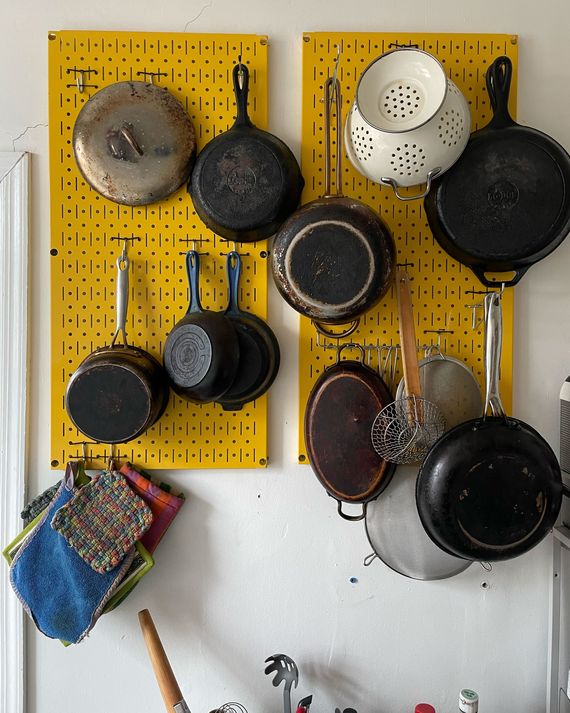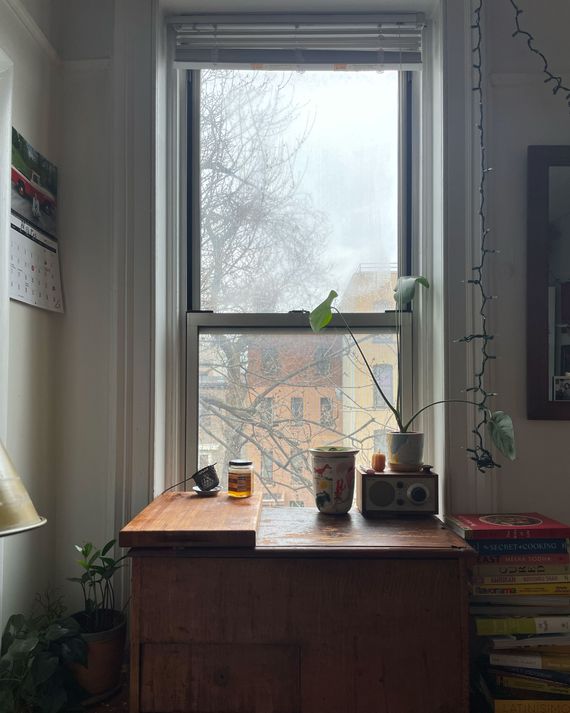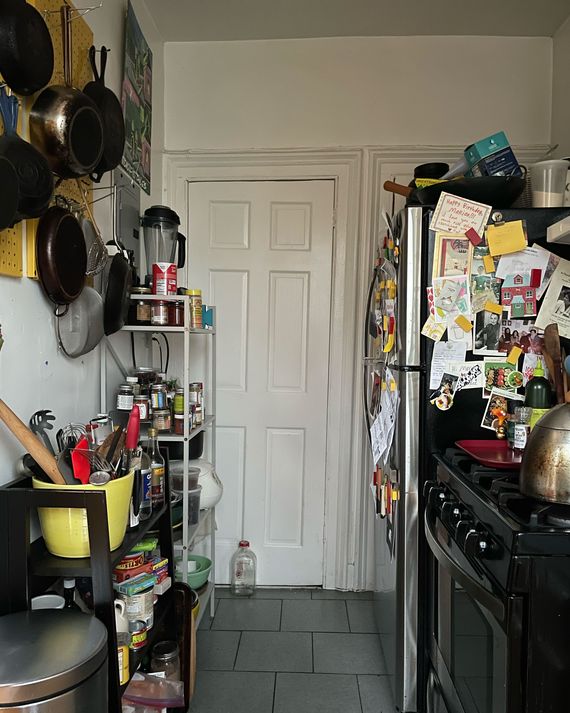Here’s How to Cook Big Meals in Your Small Kitchen


For close to seven years now, I’ve lived in an apartment with a teeny kitchen and no countertops. Mine is a standard galley: a straight line of sink, stove, and fridge facing a hodgepodge of overstuffed shelves. The narrow strip in between mostly refuses to fit more than one person. The kitchen nearly kept me from taking the place — I am something of a hoarder and also a food writer — but the good light, the claw-foot tub, and the little half-bedroom off the actual bedroom tipped the scales, so I decided instead to retrofit my often messy cooking life into its narrow 35 square feet. Now, I ping through the space like a pinball, choreographing my desires in the few feet between cutting board and stove and sink and shelf, rehearsing a dance performed for and by one.
My kitchen, which means my kitchen and the parts of my living room I have annexed as an extension of the kitchen, is light on work space and heavy on storage. It survives on a balance of scarcity and abundance: While building out the space I had to decide what I absolutely needed to get absolutely everything I wanted. On the wall facing the stove is a pair of yellow peg boards that hold three cast-iron pans, a colander, two small and one medium-size pots, and an assortment of potholders, strainers, and lids. These pots and pans boil pasta, simmer tomato sauce, fry pork chops or thick slices of bread. In the smallest ones I’ve developed a habit of blanching greens, then boiling a packet of instant noodles, then afterward sloppily poaching an egg, a meal that requires zero chopping. The knives live on a magnetic strip on the stove, for a bit of quotidian danger. My cabinets (three doors’ worth) hold mugs, bowls, plates, and wine cups. In the space between them and the ceiling lives my grandmother’s Dutch oven, a blue stockpot, and a stand mixer. (The latter I got for free, from an old job, which means I can’t give it away even though I so rarely use it.)


Because I lack actual countertops, my prep space is an inherited antique cabinet (a commode, if you want to be specific) repurposed as a butcher block that’s been foisted into the corner of my living room just outside the kitchen. Half of it is taken up by a big honker of a cutting board, and I should probably get rid of the small radio that sits on a back corner, but it’s too pleasant to turn on WBGO in the morning while making one to three cups of tea, and pragmatism can only get you so far. Next to the radio is a tall narrow ceramic vessel where I deposit my compost each day. Things like onion, garlic, bananas, and winter squash live on the dining table within arm’s reach of the commode. When company arrives, they live atop the nearest stack of books. The only piece more important than the commode, in terms of sheer functionality, is the old high-school lunch tray that covers half of my stove. (When I was a senior, my high school threatened to remove lunch trays from the cafeteria in an effort to minimize food waste, and being the brats we were, we stole them in protest.) Here go condiment bottles ready to be poured, or spices ready to be pinched, bowls of chopped garlic or ginger or carrot, lined up like synchronized swimmers poised to dive.
Mise en place — the practice of chopping, portioning, and peeling your ingredients and setting them out before you begin cooking — is particularly important in a small kitchen. If the kitchen isn’t elegant, your movements inside it must be. I chop some long eggplants on the cutting board, I transfer them to a bowl, I slide over to the stove, and the bowl goes on the tray. I pull five bottles of stuff to be measured into sauce, cluttering and then decluttering the commode after a dark thick mixture appears in a bowl, whisked with a fork and then whisked off to the tray. The tray becomes crowded now, with its beer stein of wooden spoons, my eggplant and stir-fry sauce, and little bowls of ginger and garlic and shattered dried chile.
Clean as you go becomes less of a rule than a threat. I often think of the kitchen as a pair of lungs, expanding with mess, contracting with tidying, and the cleaning, like breathing, is constant. The sink fills, then empties. (I was recently gifted an over-the-sink drying rack, which is particularly efficient. Before that, I used a metal slab, painted white, that came with the apartment.) The commode fills, then empties. The tray fills, then empties. Sometimes everything is full, and that is when things get scary — the only answer is putting things away. But this constant flux is the pleasure of cooking, of kitchen-having. It is creating and knowing your own space, tracking its growth, tending to it, cleaning it when you must.
Photo: Marian Bull
Once a month or so, I stretch my kitchen to its limits. I’ll invite three or four people for dinner, the most my table can hold without relegating people to the floor, and I’ll plan a big meal, three or four recipes. I’ll block out an afternoon and let my prep spill out onto the dining table, sometimes even the coffee table, bowls of chopped vegetables or marinating tofu or a reluctantly stirred dough. This work always takes longer than I expect, and it always drives me a little insane, makes me wish I weren’t this sort of person. But I think it’s important to show yourself what your kitchen can do.
Endless space in the kitchen can be mistaken as the room necessary for something like mastery. If I had a large kitchen, we think, I’d be the sort of person to make a feast.
The Nancy Meyers kitchen — spacious, double islands, all that marble — has become the aspirational shorthand for domestic luxury and culinary seriousness in the past decade. But it’s actually the kitchen in Ang Lee’s Eat Drink Man Woman that I dream of. The film begins with one of cinema’s greatest cooking scenes as a father in Taipei prepares Sunday dinner for his daughters: He guts and fillets a live fish, slices pork belly and radish, fills and steams endless dumplings, washes bushels of greens, boils a chicken that was so recently living in his back alley. The kitchen is simple but so clearly his own. His body flits seamlessly from task to task, a kind of muscle memory, constantly returning to a round butcher block whose belly has bowed from years of chopping and smashing. My own meals are smaller, but this is the industrious energy I try to cultivate in my own space: a dense site of possibility, cluttered with utility. Each pot is hung not to look beautiful but because that is just where it needs to be. It is a kitchen built not in anticipation of cooking but through a life of cooking. It is filled with practical things and built for bounty.
Source link





